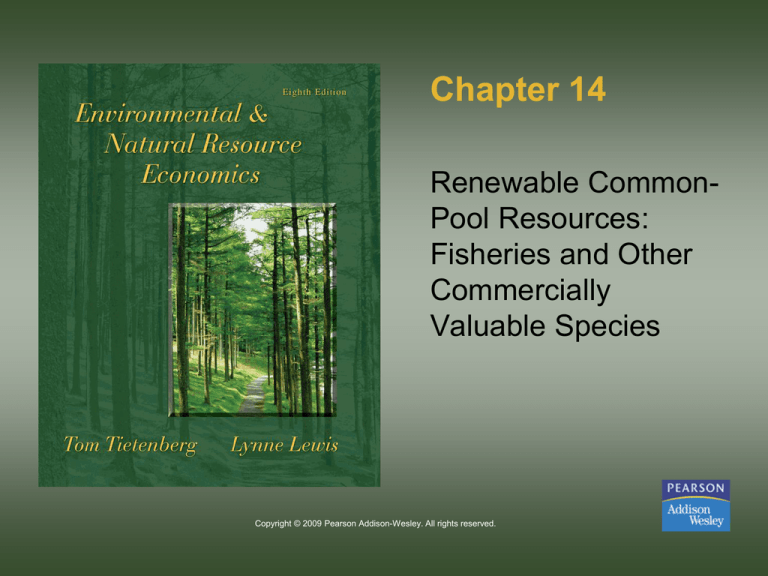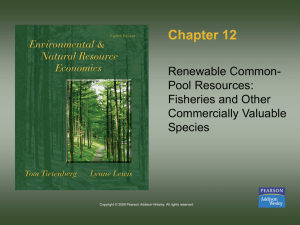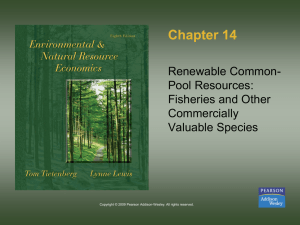
Chapter 14
Renewable CommonPool Resources:
Fisheries and Other
Commercially
Valuable Species
Copyright © 2009 Pearson Addison-Wesley. All rights reserved.
Introduction
• This chapter examines renewable resources
with biological growth.
• This chapter focuses on common pool
resources (fisheries).
• An economic model is integrated with a
biological model.
• Efficient levels of harvest are defined and
economic incentives for sustainable harvests
are discussed.
Copyright © 2009 Pearson Addison-Wesley. All rights reserved.
14-2
Objectives
• Present the Schaefer model.
• Define static-efficient sustainable yield.
• Discuss the difference between the open-access and
static-efficient outcome.
• Present and discuss dynamic efficiency and the
effect of the discount rate.
• Discuss the two types of externalities created with
free-access.
• Present public policy options for fisheries
management and the pros and cons of each option.
Copyright © 2009 Pearson Addison-Wesley. All rights reserved.
14-3
Efficient Allocations
Biological Dimension—The Schaefer model
• The Schaefer model posits an average
relationship between the growth of the fish
population and the size of the fish population.
• The shape of the graph (Figure 14.1) shows
the range of population sizes where
population growth leads to population
increases and a range where population
growth will lead to stock decreases.
Copyright © 2009 Pearson Addison-Wesley. All rights reserved.
14-4
FIGURE 14.1 Relationship between the
Fish Population and Growth
Copyright © 2009 Pearson Addison-Wesley. All rights reserved.
14-5
Static Efficient Sustainable Yield
• The static-efficient sustainable yield is the catch level
that, if maintained perpetually, would produce the
largest annual net benefit.
• Assumptions of the economic model are:
The price of fish is constant and does not depend on the
amount sold.
The marginal cost of a unit of fishing effort is constant.
The amount of fish caught per unit of effort expended is
proportional to the size of the fish population.
• The static-efficient sustainable yield allocation
maximizes the constant net benefit.
Copyright © 2009 Pearson Addison-Wesley. All rights reserved.
14-6
FIGURE 14.2
Efficient Sustainable Yield for a Fishery
Copyright © 2009 Pearson Addison-Wesley. All rights reserved.
14-7
Appropriability and Market Solutions
• A sole owner of a fishery would have a welldefined property right to the fish and would
want to maximize his or her profits.
Profit maximization will lead to the static-efficient
sustainable yield.
• Ocean fisheries are typically open-access
resources. Thus, no single fisherman can
keep others from exploiting the fishery.
Copyright © 2009 Pearson Addison-Wesley. All rights reserved.
14-8
FIGURE 14.3
Market Allocation in a Fishery (1 of 2)
Copyright © 2009 Pearson Addison-Wesley. All rights reserved.
14-9
FIGURE
14.3
Market
Allocation
in a Fishery
Copyright © 2009 Pearson Addison-Wesley. All rights reserved.
14-10
• Raising the real cost of fishing through
regulation is another policy option.
Raising the marginal cost of effort results in a
lower harvest and higher stock sizes.
While the policies may result in an efficient catch,
they are inefficient because the efficient level of
catch is not caught at the lowest possible cost.
Technological innovations have lowered the cost
of fishing, offsetting the increases imposed by
regulations.
Copyright © 2009 Pearson Addison-Wesley. All rights reserved.
14-11
FIGURE 14.7 Effect of Regulation
Copyright © 2009 Pearson Addison-Wesley. All rights reserved.
14-12
Individual Transferable Quotas (ITQs)
• An efficient quota system will have the
following characteristics:
The quotas entitle the holder to catch a specified
volume of a specified type of fish.
The total amount of fish authorized by the quotas
should be equal to the efficient catch level for that
fishery.
The quotas should be freely transferable among
fishermen.
Copyright © 2009 Pearson Addison-Wesley. All rights reserved.
14-13
TABLE 14.1 Countries with Individual
Transferable Quota Systems
Copyright © 2009 Pearson Addison-Wesley. All rights reserved.
14-14
Subsidies and Buy Backs
• One of management options to reduce
overcapacity.
Payments used to buy out excess fishing capacity
are useful subsidies, but if additional capacity
seeps in over time, they are not as effective as
other management measures.
Copyright © 2009 Pearson Addison-Wesley. All rights reserved.
14-15









